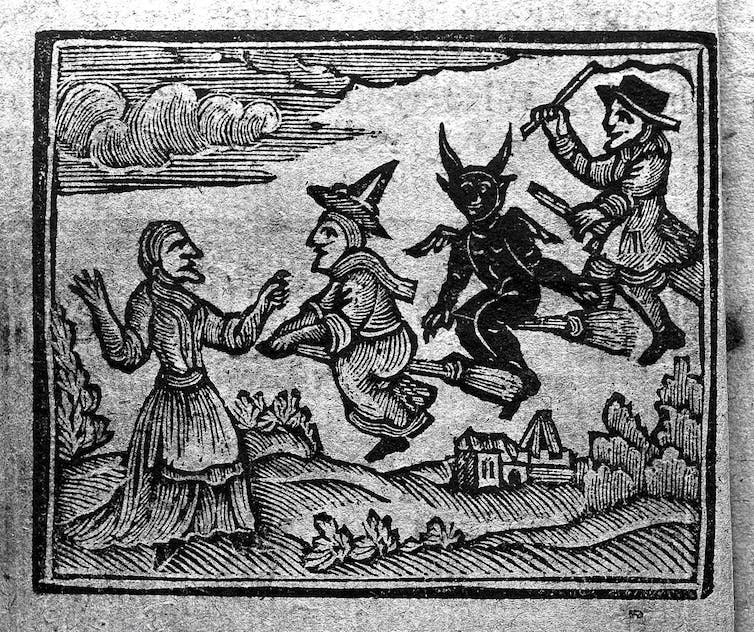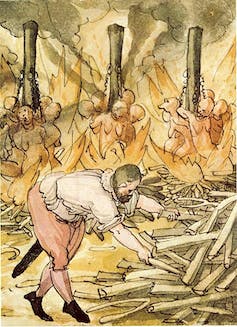Three girls executed as witches in Derneburg Germany in October 1555 Everett Collection
About 400 years in the past, the European witch hunts have been at their peak. Between the fifteenth and 18th centuries, an estimated 50,000 individuals, principally girls, have been executed for witchcraft throughout Europe. They have been accused of devil-worship, heresy and harming their neighbours through the use of witchcraft.
The 1620s was probably the most intense section of persecution in locations like Eichstätt in Germany, the place virtually 300 witches have been executed between 1617 and 1631.
The witchcraft trials have endured as a matter of curiosity, leisure and debate. But regardless of this curiosity, well-liked understandings of the European witch-hunts are riddled with error and misconceptions. So, given it’s the season of the witch, it’s time to dispel some myths.
1. Witchcraft is a medieval concept
It isn’t – it’s fashionable. The Christian church was sceptical in regards to the actuality of witchcraft till the fifteenth century. Even then, many theologians and clergymen didn’t consider that witchcraft was a risk.
The first trials of people that have been believed to be malevolent worshippers of the Devil who actively triggered hurt occurred within the fifteenth century. The most intense interval of witch searching ran from about 1560 to about 1630.
Before that there have been only a few witchcraft trials, as a result of acts of witchcraft have been believed to be an phantasm attributable to the Devil with the permission of God.

Witches on broomsticks, featured in The History of Witches and Wizards (1720)
The Wellcome Library
2. Witchcraft trials occurred all over the place
Most witchcraft trials occurred in central, western, or northern Europe. These have been the areas which have been the cradle of the Protestant and Catholic Reformations, which noticed the transformation of the non secular geography of Europe. And the northern Renaissance and the scientific revolution had reworked how the world was understood.
More than 50% of all trials in Europe occurred in Germany. But even there, witch persecution was restricted to some of the very many autonomous and semi-autonomous territories of which it was comprised.
In locations like Iceland and Wales, there have been only a few witchcraft trials in any respect. It appears that native beliefs about magic and witchcraft, alongside the attitudes of clergymen and judges, will be the causes for this.
3. The Inquisition tried and executed most witches
The Roman, Spanish and Portuguese Inquisitions, established within the sixteenth century, have been answerable for coping with issues of heresy. They have develop into infamous for his or her rigour in rooting out opposition to Catholic orthodoxy. Yet, they burned only a few witch suspects. Across the entire of the Iberian and Italian peninsulas, the inquisitions executed fewer suspects than have been hanged in England.
The Spanish Inquisition put a cease to the witchcraft trials that had spilled over from France within the early seventeenth century by assuming jurisdiction over witchcraft accusations.

The execution of alleged witches in central Europe, 1587.
Zurich Central Library/Wikimedia
4. Only girls have been tried for witchcraft
It’s true that 80% of these tried and executed for witchcraft have been girls. Many witch hunters, like these in Eichstätt, additionally chosen feminine suspects over male ones, although the proof might be very comparable.
However, in some locations, like Russia, it was males who shaped nearly all of witch suspects. This was primarily as a result of Russians conceptualised gender very in another way to individuals in western Europe.
Regardless of whether or not the witch suspects have been accused earlier than magistrates or denounced below torture, their feminine neighbours have been those probably to accuse them.
In England, girls on the margins of society have been extra weak to accusations of witchcraft when issues went fallacious for his or her neighbours, akin to inexplicable deaths or hurt. This was the case with Ursley Kemp, one of many two witch suspects of St Osyth, Essex, who have been hanged in 1582. Kemp was a marginal determine within the city, a lady with an illegitimate son making ends meet by her therapeutic expertise.
In Eichstatt, it was a product of the processes of torture. When the suspects (greater than 90% of whom have been girls) needed to identify names below torture, they gave these of their neighbours. The suspects’ networks have been based on their intercourse; girls named girls and the few male suspects named males.
5. Witches have been actually the followers of a pagan fertility cult
This fantasy was promoted by the Egyptologist Margaret Murray within the early twentieth century and was then debunked by the historian C. L’Estrange Ewen virtually as quickly because it appeared. It was based on a partial studying of the accessible witchcraft proof.
It continued as a result of Murray wrote the Encyclopaedia Britannica article on witchcraft that remained in print for 40 years, till 1969, and actively supported the brand new Wiccan faith in print within the Nineteen Fifties. This new faith was based by Gerald Gardner who revived what he believed to be historical pagan witchcraft within the Nineteen Thirties. But it has no materials connection to any type of historic witchcraft.
Most witches have been atypical Christian girls who discovered themselves accused of witchcraft by their neighbours, or denounced by different suspects below torture.

Looking for one thing good? Cut by the noise with a rigorously curated number of the newest releases, dwell occasions and exhibitions, straight to your inbox each fortnight, on Fridays. Sign up right here.
![]()
Jonathan Durrant doesn’t work for, seek the advice of, personal shares in or obtain funding from any firm or organisation that might profit from this text, and has disclosed no related affiliations past their tutorial appointment.
